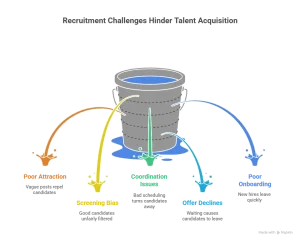There’s a lot more to hiring than filling some seats. You need to choose someone very carefully, because they will be impacting your team, culture, and results. If you are still treating recruitment like a checklist of sorts, you are missing out on some major wins.
It’s time to turn to the recruitment life cycle. It’s your roadmap to hiring right. Starting from identifying what role you need to onboarding the perfect candidate, it covers each phase.
In this blog post, we will be discussing all the key stages, including job posting, sourcing, screening, interviews, offers, onboarding. We will also go into detail about how each one affects your hiring efficiency, candidate experience, and long-term team alignment.
So keep reading on till the end to know what the full recruitment process looks like, how to avoid common missteps, and what strategies actually work.
What is the Recruitment Life Cycle?
It is the entire process of bringing someone into your organization, from the moment you realize you need to hire to the day your new employee settles into their role.
The full recruitment cycle aligns your hiring goals with business objectives, improves the quality of your hires, reduces time to fill, and strengthens the candidate experience. Partial recruitment, by contrast, only covers a few steps, like sourcing or interviewing, and often leaves gaps in accountability or strategy.
Whether you’re an HR leader or a hiring manager, understanding the life cycle of recruitment helps avoid costly recruitment mistakes and sharpens decision-making. It’s not just about hiring faster. It’s about hiring better.
Key Stages of the Recruitment Life Cycle Explained
Every phase in the recruitment process has a job to do. If one falls short, the others get shaky. This is how each stage holds up the structure.

1. Job Analysis and Role Definition
Filling a role when you don’t know what you need is like offering a solution to a problem you don’t fully grasp. It’s extra steps and no results.
Be clear about what you are looking for. Is this a new position? Or are you replacing someone? What skills, experience, and outcomes look like for someone filling that seat?
Collaborate with department heads to craft role requirements. Define responsibilities, KPIs, and soft skills needed for that role. Clear job descriptions attract the right candidates. And a big part about recruitment is attracting the right ones to apply and be a part of your team.
Make sure this matches with your company’s wider goals too. Otherwise, you’ll be just hiring off-track. And that will only add frustration with resources that could have been better spent.
When defining the role and performing the job role, remember that the hiring trends are shifting. Especially these days as return to offices is making another comeback and promised hybrid roles don’t stay hybrid for too long.
With these shifts happening, the priorities of job applicants is shifting too. So stay relevant with market expectations when drafting the job role and duties.
2. Sourcing and Attracting Candidates
You have nailed the first step by defining the role. Now, it’s time for you to find people who fit. Use every appropriate channel for this. Go on job boards. Post strategically on social media. Rely on internal referrals. And turn to your professional networks like LinkedIn.
This is also the part where many employers realize all too late that strong employer branding goes a long way. Your job post becomes your pitch. So make it compelling.
Don’t just list what you offer. Make those potential applicants want to work for you, to be a part of your team, to plan their careers with your company as their goal. Reflect your company values. Clearly highlight the perks you provide.
If you want to dig even deeper in search of talent, use sourcing tools. And don’t just limit your focus on active candidates. Passive candidates often go on to become the best hires. All they need is a little nudge. If you want to recruit passive candidates, RAAD can assist you with this one!
3. Screening and Shortlisting
You defined the role. Then you spread the word. That brought in countless of applications and resumes. Now, it is time for you to trim the list. An ATS, Applicant Tracking System, helps sort through the volume.
Filter out any hiring red flags early on with pre-screening calls. Identify gaps and patterns in resumes. And watch out for unconscious bias. Screening is often where bias silently sneaks in. Address it before it sabotages your recruitment stages.
4. Interview and Evaluation
It is about time interviews were used to confirm potential, not just to test nerves. Choose the right structure for what you are hiring for. If you are hiring for consistency, go with structured. If it’s flexibility you want in the role, opt for an unstructured interview.
Use scorecards and clear rubrics to evaluate both technical and soft skills. Train interviewers to avoid vague impressions and thoroughly document their feedback.
Consistency across interviews matters. You’re hiring the right talent, not just someone who gives a good first impression.
5. Selection and Offer Management
By now, you should have top candidates backed by solid feedback. This is the decision stage.
Conduct final interviews if needed. Though, it’s best to limit the number of interview rounds to a minimum.
Prepare a strong job offer, listing their salary, benefits, and growth opportunities. Send it fast because delays can lose great talent. Because honestly, if they are a great talent, your company isn’t the only one looking to hire them.
Expect negotiations. Be transparent but flexible. Start pre-boarding too. Collect necessary documents, prepare IT access, and keep your teams in loop.
This is also a good time to introduce company policies, like types of leave, to avoid mismatches in expectations later on.
6. Onboarding New Hires
First impressions stick. A smooth onboarding sets the tone for retention and engagement.
Welcome them with team intros, company walkthroughs, and access to essential tools. Set expectations early. 30/60/90-day plans are gold.
Assign mentors or buddies for cultural integration. Check in frequently during the first 30 days to fix any bumps before they grow.
Don’t forget paperwork and admin tasks like notice period handovers. It’s the little things that create a great experience.
7. Post-Recruitment Evaluation
Hiring doesn’t end when they sign the offer letter. This final stage helps you assess how effective your process was.
Track metrics like time to hire, cost per hire, and retention rates. Ask for feedback from both the candidate and hiring managers.
This is where you catch these hurdles and improve recruitment process stages for next time.
Common Challenges Faced at Different Stages of Recruitment
Each stage of the recruitment life cycle has its own struggles. Let’s go over them and how to fix what’s broken.

Attracting Qualified Candidates
If no one’s clicking your job post, it might not be the algorithm or people not wanting to work. It might be the job post itself. Vague titles and bland descriptions don’t sell. Add poor employer branding, and you are practically invisible.
Diversify sourcing. Don’t rely on just one or two job boards. And don’t believe all the outsourcing myths. There are outsourcing partners out there who bring the right talent to you.
Screening and Bias
We have seen it happen many times. Either the hiring teams go overboard with automation. Or they fall back on their ‘instincts’ too much. But both can fail you. Because what happens here is bias creeping into resume reviews. This means many good candidates get unfairly filtered out.
Use structured scorecards and cross-team shortlisting to balance it out.
Interview Coordination Issues
Interviews fall apart when no one actually owns the calendar. Nothing turns away a candidate as fast as bad scheduling and feedback delays.
So keep your team trained, aligned, and equipped with templates to move quickly.
Offer Declines
Top talent quickly climbs up the career ladders. If you wait too long with your offer or lowball it, don’t act surprised when they either ghost your call for that seventh round of interview you are still conducting.
Or when they outright tell you they have already signed up with your competitors months before you picked up the phone to negotiate with them because they never heard back from you.
Do your market research and have your package ready to go the moment you finalize who you are hiring.
Poor Onboarding
One of the best feats is hiring someone great. One of the worst is losing them when you are just halfway into week one. Don’t be that company.
Not providing proper work equipment? No HR walkthroughs? If that’s what your current onboarding looks like, you are not building an empire. You are building regret and letting it fester among your workforce.
Don’t make these mistakes that cost not only in money and resources but in reputation as well. Instead, create structured plans and assign a buddy to smooth their landing.
The biggest recruitment challenges often stem from disjointed or rushed processes. Fix the pieces and the whole improves.
How to Streamline Your End-to-End Recruitment Life Cycle
No, you don’t need to reinvent hiring. All you need to do is remove what’s been causing friction in moving forward with the process and add some structure to it.
Organize the candidates shortlisting and track their progress by using ATS and recruitment CRM. Build standardized job templates and interview kits.
Train your hiring teams. Use feedback loops. Track the time it takes to fill a position and compare it across roles.
Double down on employer branding. Your candidates are judging you before you ever get to see their resume.
Want assistance with managing all of this? Our staff outsourcing services offer tools and people to simplify hiring at scale.
Recruitment Life Cycle vs Employee Life Cycle: What’s the Difference?
Don’t mix these up as they cover different parts of the employee journey.
The recruitment life cycle runs from job need to onboarding. It’s focused on finding and securing the right person.
The employee life cycle starts after that. It involves development, performance, promotions, engagement, and offboarding.
Understanding both helps you build long term HR strategies and avoid drop-offs at handover points.
Final Thoughts: Build a Better Recruitment Process
Every stage in the recruitment cycle matters. Skipping even one of them means you are running the risk of poor hires, longer timeframes, and burned out teams.
That’s why you should use data to guide your tweaks. Improve your candidates’ experience and manager alignment. Add tools and training wherever they are missing.
And if this is sounding like a lot of workload, don’t stress. Because RAAD Recruitment helps businesses like yours optimize every part of their recruitment cycle. From sourcing to onboarding, our years of experience means we know what to do.
Check out our recruitment support services to start building a smarter hiring process today. Or contact us now.
FAQs About the Recruitment Life Cycle
What Are the Main Stages in The Recruitment Process?
- Job analysis
- Sourcing
- Screening
- Interviewing
- Selection
- Onboarding
- Post-hire evaluation.
How Long Does a Typical Recruitment Life Cycle Take?
It can range from a few weeks to several months. High-skill roles usually take longer.
What Tools Can I Use to Improve the Recruitment Process?
- Applicant Tracking Systems
- Recruitment CRMs
- Sourcing tools like LinkedIn Recruiter
- Scheduling platforms like Calendly
Why Is Onboarding Part of The Recruitment Life Cycle?
Because it’s the bridge between hiring and working.
How Do I Avoid Bias in Recruitment?
Use these methods:
- Structured interviews
- Blind resume screening
- Cross-functional hiring panels
What Metrics Should I Track in The Recruitment Process?
- Time to fill
- Cost per hire
- Quality of hire
- Candidate satisfaction
- Retention rates
Is the Recruitment Life Cycle Different for Remote Roles?
Yes. Digital onboarding and time zone coordination are where it differs.







